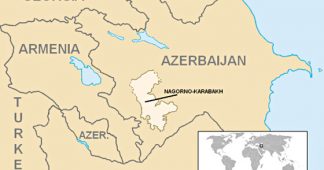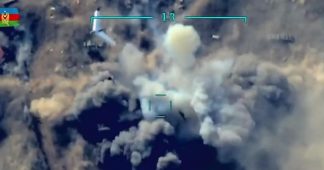New evidence found by Human Rights Watch reveals that Baku’s forces repeatedly used cluster bombs in Nagorno-Karabakh
23 October 2020
New evidence has emerged corroborating claims that Azerbaijan has used Israeli-made cluster bombs during recent fighting against Armenia in the Nagorno-Karabakh region.
Human Rights Watch identified at least four incidents when Azeri troops used cluster bombs indiscriminately in Stepanakert, the capital of Nagorno-Karabakh, and the town of Hadrut.
The rights group found remnants of an unexploded Israeli-made LAR-160 series cluster munition rocket and M095 dual-purpose submunition in heavily residential areas in Stepanakert and Hadrut. Each rocket carries 104 submunitions and each submunition is equipped with a self-destruct mechanism.
Azerbaijan received these surface-to-surface rockets and launchers from Israel between 2008 and 2009.
Neither Armenia nor de facto authorities in Nagorno-Karabakh are known to possess cluster munitions, although they possess multi-barrel rocket launchers capable of firing these weapons.
The weapons typically scatter submunitions over a wide area, where they often fail to explode, posing a long-term threat to civilians.
HRW also found distinctive impact patterns of an M095 dual-purpose improved conventional munition (DPCIM) on the ground accompanied by a pink-coloured ribbon.
HRW was not able to identify any military equipment or bases in the three neighbourhoods where the attacks took place.
Residents of Stepanakert told HRW that attacks using cluster munitions began in late September in a residential area 200 metres from the office of the Red Cross.
A woman who spoke to the rights group said that she saw scores of the distinctive impacts of the M095 submunitions, noting how the building she lived in began to shake when the cluster bombs were deployed.
“The children started to scream, and everyone was panicking when the bombs started coming down. We opened the windows and saw that the cars were burning,” the 69-year-old woman told HRW.
“We saw that they had small pink things that were making them burn, so we ran down to the basement.”
She said that several submunitions did not explode and that people in the
neighbourhood covered them with sand from the children’s playground until emergency responders came the next day to secure and remove them.
Over 100 countries have signed a 10-year-old convention banning the use of the munitions, but neither Armenia, Azerbaijan nor Israel are signatories.
“The continued use of cluster munitions – particularly in populated areas – shows flagrant disregard for the safety of civilians,” said Stephen Goose, arms division director at Human Rights Watch and chair of the Cluster Munition Coalition.
“Cluster munitions should never be used by anyone under any circumstances, much less in cities, due to the foreseeable and unacceptable harm to civilians.”
HRW’s findings confirm footage analysed by Amnesty International that identified the use of Israeli-made M095 DPICM cluster munitions by Azeri forces in Stepanakert.
Amnesty noted in September that M095 DPICM cluster munitions in Stepanakert appeared “to have been fired by Azerbaijani forces” towards resident areas of the city.
Nagorno-Karabakh broke away from Azerbaijan in the 1990s, prompting a long unresolved conflict that has seen tens of thousands of people killed.
Both Turkey and Israel have fervently supported Azerbaijan’s claims to territorial integrity, while Armenia has been historically closer to Iran and Russia.
Published at https://www.middleeasteye.net/news/azerbaijan-armenia-israel-cluster-bombs-used-hrw











